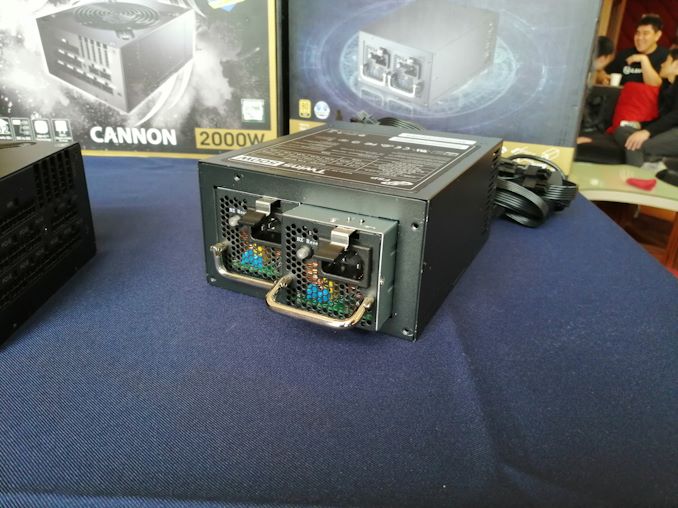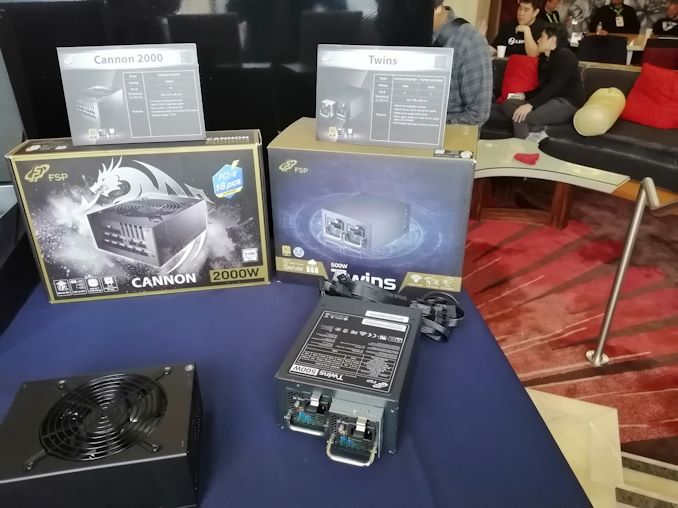FSP Twin Redundant PSU: 900W Due Later This Year
by Ian Cutress on January 8, 2019 8:30 AM EST- Posted in
- PSUs
- FSP
- Trade Shows
- FSP Twins
- CES 2019

The consumer market is not used to the idea of redundant power supplies. For the enterprise market, redundant PSUs give peace of mind by eliminating a single point of potential failure. It can also protect the components should one power supply have a mishap, as the other supply can take over. The power supplies can be hot plugged as well, keeping the system alive in case one power supply needs to be replaced. For desktop/workstation users who want this level of security, there have not been many options to choose from except to purchase from the enterprise market. Last year, FSP introduced its 'Twin' range of redundant power supplies for consumers.
Over 2018, the company introduced two units, a 700W and a 500W model. The hardware fits into a standard ATX power supply bay, and the only difference in setups will be that two power cords are needed. The pickup of these units in certain markets has been so good, the company is working on a 900W model to address the higher-end of the target market. We were told that work on this unit is ongoing, and likely to be shown at the end of the year. FSP makes its own power supplies as an ODM, so they want to also hit the efficiency points as well. I was told that I'll likely see it either at Computex later this year or next year at CES.











17 Comments
View All Comments
Manch - Tuesday, January 8, 2019 - link
I'm hard pressed to see a use case for this at home. An UPS would be a better off investment.LauRoman - Tuesday, January 8, 2019 - link
Wonder how it handles power from two different breakers. Still i fo not know what use is there for something like this even if used somwhere where breakers are often tripped accidentally or intentionally. Even there a ups is probably better (mostly if the network also has one)...LauRoman - Tuesday, January 8, 2019 - link
"Do" instead of "fo"DanNeely - Tuesday, January 8, 2019 - link
At the enterprise level, connecting to a pair of nominally independent power sources is generally part of the point.Manch - Wednesday, January 9, 2019 - link
Dan, This isn't enterprise level. RTA and the comments you're replying to. This product is for consumer market.Computeruserman - Tuesday, January 8, 2019 - link
UPS will be useless if the Power Supply Unit connecte to the motherboard fails. Hot swap PSU is very useful to people in the home with an always on HTC + Server combination, or some one working to a time sensitive work from home deadline like a Home youtuber or columnist writer. Even better if you have a lot of hardware that stressess the psu like threadripper 32Core proccessor with two rtx2080ti and two optane p4800x dedicated Sound Hardware, or a serious workstation with dual processors.Computeruserman - Tuesday, January 8, 2019 - link
Long lead times like USA to newzealand for delivery could be a pain could cost that person there job, Pitty this wont help of motherboard fails, worse yet if the misses was watching her favourite drama and it fails, you will never hear the end of it, fate worse than death LOL.Manch - Wednesday, January 9, 2019 - link
OK, fair enough but that's severely niche. PS are in general if you buy quality parts, extremely reliable. If you use an UPS to filter power, then the odds of it failing is even lower.Lots of things are single point of failure. These PSUs are worthless for your proposed setup. Not enough wattage.
The wife watches on the XBOX, ROKU, PS$, etc. I've covered that contingency LOL
wolrah - Tuesday, January 8, 2019 - link
I'd definitely agree that a UPS comes first, but UPSes also fail from time to time, especially those popular in the kinds of markets that are DIYing servers.With a single UPS a user could hook port 1 up through the UPS, then hook port 2 up directly to the mains and thus be tolerant of UPS failures without operational interruptions. If multiple legs/phases are available where this is located, connecting the second input to a different one also provides tolerance against a few more kinds of failure.
Of course the ideal case has each input going to a separate UPS which is then fed from a separate leg/phase of the actual mains power, but at that point you're getting to a level where most users are just going to be buying an OEM server rather than looking for ATX-compatible redundant PSUs.
Manch - Wednesday, January 9, 2019 - link
If your data or rig is that critical, you should run both through filtered power/UPS. You're last sentence is what Im getting at. At that point, you're buying enterprise level equipment.